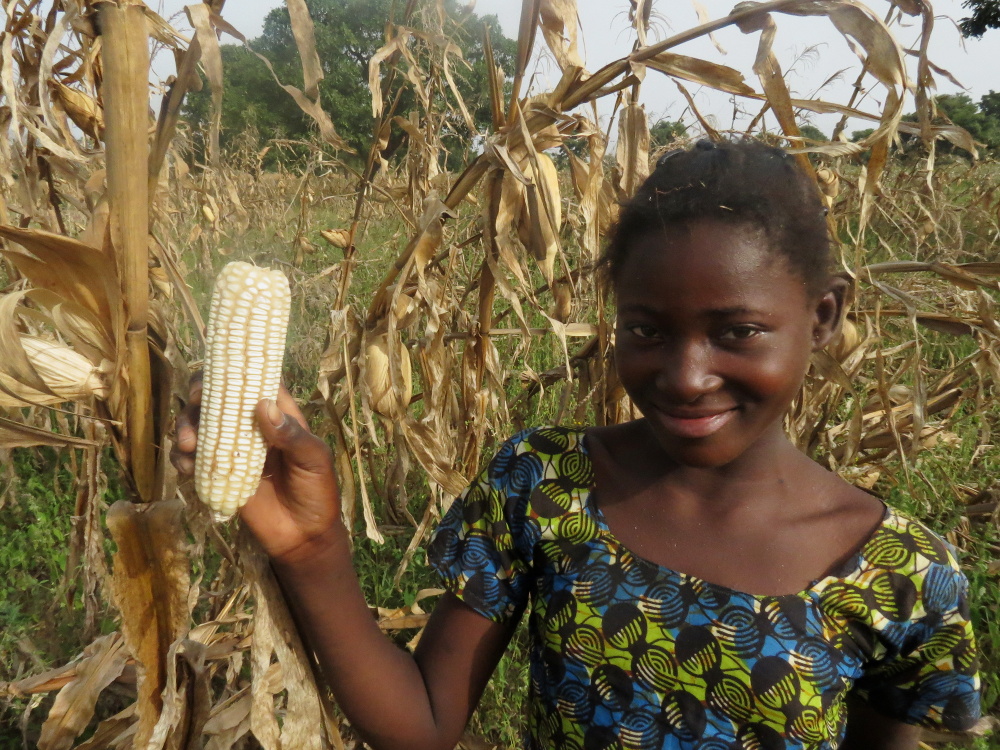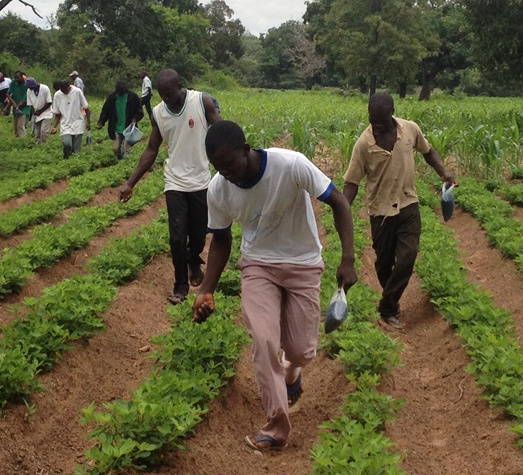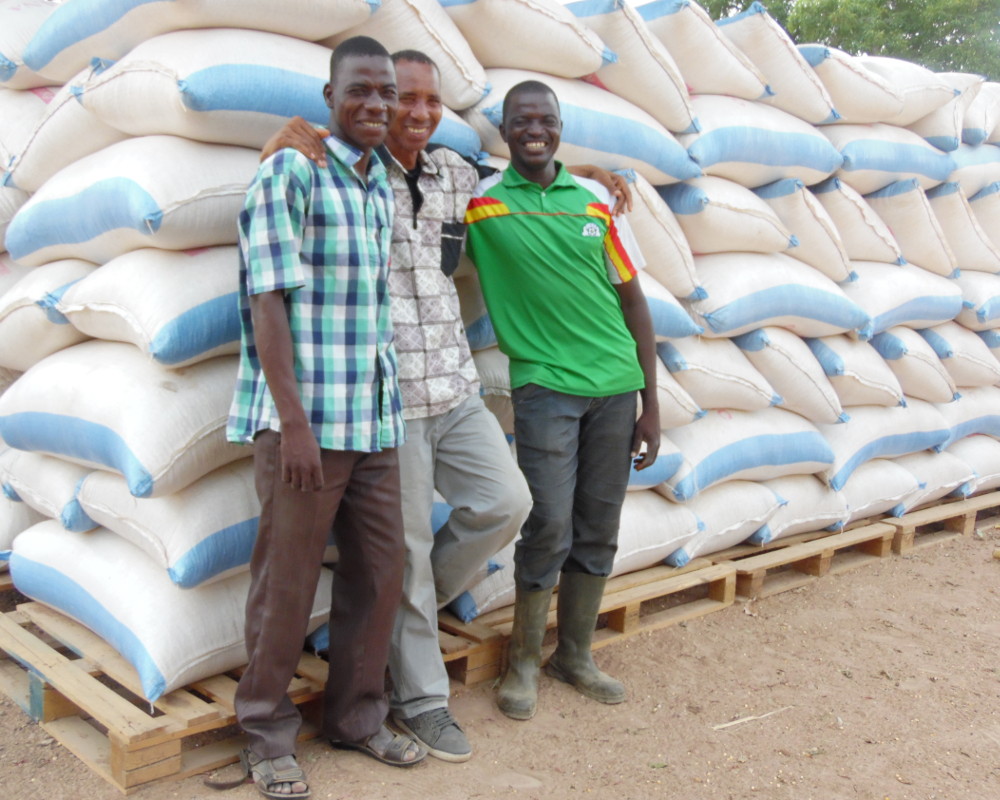One thing is clear: inaction on aflatoxin is not an option. “The health cost that we are paying, and will pay, is too high. The loss of life is too great. It is time for us to consider food safety as well as food security, not only for the farmers and traders who are losing out on income but simply for everyone. We must take care of each other.” – Dr Adama Neya, Plant Pathologist, Institut de l’Environnement et de Recherches Agricoles, Burkina Faso

The forward march against aflatoxin in Africa’s food continues, with the latest milestone being building a formidable ‘fort’ in the Land of the Upright People. In mid-2017, Burkina Faso became the latest country with its own tailor-made version of Aflasafe available and ready for commercialisation. Aflasafe BF01 was approved for full registration by Le Comité Sahélien des Pesticides (CSP, the Sahelian Pesticides Committee) of Le Comité Permanent Inter-Etats de Lutte contre la Sécheresse dans le Sahel (CILSS, the Permanent Interstate Committee for Drought Control in the Sahel) at its May meeting, with the Business Incubation Platform of International Institute of Tropical Agriculture (IITA) as the registrant.
This is good news for anyone who eats maize or groundnuts in Burkina Faso – and that is almost everyone, including infants – as Aflasafe BF01 reduces aflatoxin levels in those foods by 96% at harvest time, and by 94% even after storage in poor, humid conditions. Aflatoxin is a hidden killer, associated with problems such as liver cancer, weakening of the immune system, and stunted growth in children. By lowering the amount of the toxin in food to within safe levels, Aflasafe can alleviate grave and widespread health consequences as well as opening up new markets and income opportunities.
“We are placing a powerful tool in the hands of Burkina Faso’s farmers,” says Dr Ranajit Bandyopadhyay, Principal Scientist (Plant Pathology) and Research Leader of the Africa-wide Aflasafe Initiative at IITA. “Burkina Faso now has a solution to the problem of aflatoxin, when Aflasafe is combined with good agricultural practices.”
There are many steps to making Aflasafe available in any country, but the magic formula always involves combining both scientific and regulatory ingredients. Many years of research, development, and testing are needed to create a locally adapted product with proven effectiveness. But before it can go on sale, it must also be approved by, and registered with the appropriate authorities.
With both elements in place in Burkina Faso, the process of transferring Aflasafe to local partners for sustainable commercial production is set take off in earnest, through IITA’s Aflasafe Technology Transfer and Commercialisation (ATTC). In the course of 2017, the ATTC team met with a wide range of private- and public-sector organisations and held an investor forum in November to share the benefits of Aflasafe. Those interested in commercialising Aflasafe in Burkina Faso are preparing applications; around two to three partners will be selected, and announced in 2018.
With its registration by CILSS, Aflasafe BF01 is authorised to fight aflatoxin in maize and groundnuts in any of the organisation’s 13 member-states across the Sahel region. But since this version of Aflasafe uses strains of friendly fungi native to Burkina Faso and has only been tested in that country, it will only be available in Burkina Faso for the present. This is the fourth registration of Aflasafe products in Africa, following Aflasafe™ in Nigeria (2014), Aflasafe KE01™ in Kenya (2015), and Aflasafe SN01 in both Senegal and The Gambia (2016).
As in many African countries, aflatoxin is a serious menace in Burkina Faso. Contamination is widespread in maize and groundnuts, the staple foods that people eat every day and that underpin the agricultural economy. It is also found in various other foods from milk to chilli peppers. Aflatoxin even gets into baby food: a 2017 study examined cereal-based infant formula produced in Burkina Faso, and found that 84% contained aflatoxin B1 (the most toxic type). The worst contaminated contained 900 times more than the safety limit – which is very low for these foods, since babies are so vulnerable to the toxin.
In another study, scientists found that half of ordinary maize intended for human consumption purchased across Burkina Faso was contaminated with aflatoxin B1, all at unsafe concentrations. The picture in groundnuts was a little better – with about a quarter of samples containing aflatoxin, many within safe limits – but still a cause for concern. Scientists also tested animal feed. They found that all the samples were highly contaminated. This means that the toxin gets into animal products such as milk, as well as making poultry and livestock ill and unproductive. One of the big problems with aflatoxin is that it accumulates in our bodies throughout our lives, making any frequent consumption into a cumulative and ever-increasing health threat, even if it never causes any obvious symptoms.
“We know that companies in Europe are keen to buy groundnuts from West Africa, but at the same time, exporters from Burkina Faso have found it very difficult to trade in European markets because of high aflatoxin,” says Dr Bandyopadhyay. “We also know that agencies such as UNICEF and the World Food Programme want to procure maize from Burkina Faso, but they are unable to reliably obtain maize that is aflatoxin-safe. Meanwhile, the food that people eat is highly contaminated. Alongside proper harvesting, drying and storage, Aflasafe can eliminate this contamination almost entirely and offers both improved health and opportunities for trade.”

Aflasafe BF01 was developed by IITA, the Agricultural Research Service of the United States Department of Agriculture (USDA–ARS), and Burkina Faso’s Institut de l’Environnement et de Recherches Agricoles (INERA). It was funded by the Austrian Development Agency (2010–2014), the USDA Foreign Agricultural Service (2014–2017), the United States Agency for International Development (USAID, since 2016), and the Bill & Melinda Gates Foundation (since 2017), with the University of Natural Resources and Applied Life Sciences (BOKU, Tulln, Austria) contributing to train researchers.
One of the exciting aspects of the development of Aflasafe BF01 in Burkina Faso has been the enthusiastic support and involvement of farmers’ organisations and private industry at every stage of the process, providing invaluable help in collecting initial samples, testing Aflasafe under real-world conditions and giving demonstrations and training to farmers and others working in agriculture and food. These participants included: Neema Agricole du Faso (NAFASO), a seed company in Bobo Dioulasso; Centrale de Transformation de Produits Agricoles (CTRAPA), a private processor in Ouagadougou; Fédération des Professionnels Agricoles de la Sissili (FEPASSI, the Federation of Professional Producers of Sissili, now known as FNZ), a large farmers’ organisation in Sissili Province; Yahi Goè (“Do it well”), a farmers’ organisation in Yindéré; the Inter-professional Committee for Cereals and Cowpea of Burkina (CIC-B); the Coopérative de Prestation de Services Agricoles (COPSA-C) at Founzan; Wend-Songda at Boromo; and the Cooperative of Agricultural Entrepreneurs in the district of Koumbia.
The role of these organisations as intermediaries is also very powerful: in representing farmers and industry they help champion Aflasafe to government agencies, and farmers’ groups encourage individual member farmers to try Aflasafe by boosting awareness and providing a guaranteed good price for aflatoxin-safe grain, which they are able to store and market collectively.
This benefits farmers too, as they have gained knowledge and tools and received support in using Aflasafe. Says Mrs Kambou Félicité Yaméogo, Director of COPSA-C: “For the first time, I learnt the real negative effects of maize and groundnuts contaminated by aflatoxins. We mistakenly think that washing the grains make them safe and usually we give the infected grains to poultry. The cooperative will greatly encourage farmers to use Aflasafe along with other best practices in our network of 3,000 members in Ioba Province.” COPSA-C has found that the demand for aflatoxin-safe maize currently far outstrips their current supply. They plan to sell some of their grain directly to buyers, and also add value by processing some into couscous and selling it to local people in their own stores.
Marc Bognini is one of the COPSA-C members who has tested Aflasafe BF01, working closely with Dr Adama Neya, Plant Pathologist with the INERA Cereals Programme, who has been one of the key INERA scientists working on Aflasafe BF01. In 2016, Mr Bognini applied Aflasafe on 18 hectares of maize, and at harvest he kept back enough to feed his household of 35 people. He sold the remainder, 186 100-kg bags, to COPSA-C and other clients at over USD 26 per bag, compared to USD 19 at the local market. This was 38% higher, translating into more than USD 1,350 extra earnings. “This is the best deal I have ever had in my life,” he says. “I recommend Aflasafe BF01 to all the farmers I meet. I am strongly convinced that we can expect a better price and protect consumers from cancers.”

The demand for Aflasafe is only likely to grow in years to come, as farmers and consumers are tending to switch from sorghum to maize, while maize is also increasingly being used as feed by the growing poultry industry. One thing is clear: inaction on aflatoxin is not an option. “The health cost that we are paying, and will pay, is too high. The loss of life is too great,” says Dr Neya. “It is time for us to consider food safety as well as food security, not only for the farmers and traders who are losing out on income but simply for everyone. We must take care of each other.”
To that end, commercialisation activities continue apace, with the selection of local partners to produce, distribute and market Aflasafe BF01. Meanwhile, farmers are keen to explore its possibilities even further, and the next step will be to test its effectiveness in more crops such as sesame and chilli peppers, should funds be found. What is certain is that the people of Burkina Faso can look forward to more and more safe food on their plates.
Where else can you find Aflasafe in Africa? See the cross-continental picture at Aflasafe where I am










